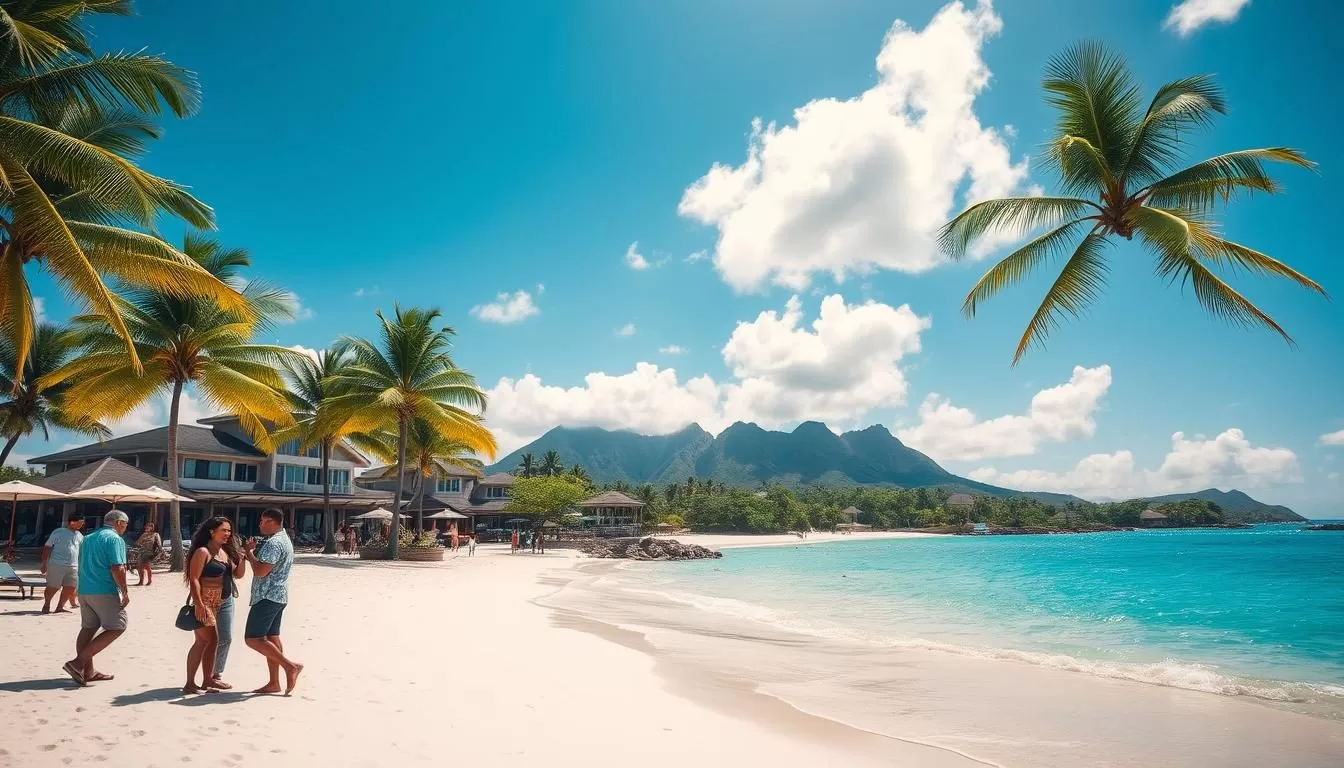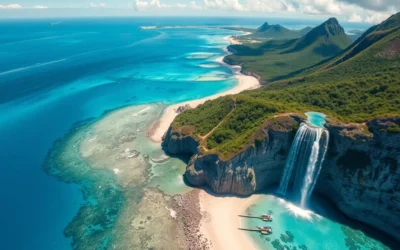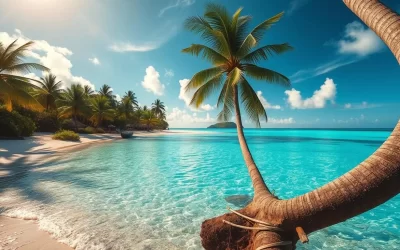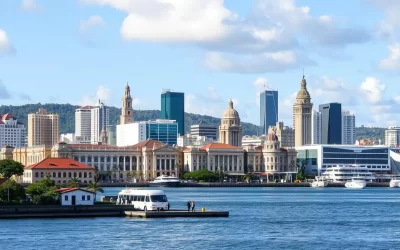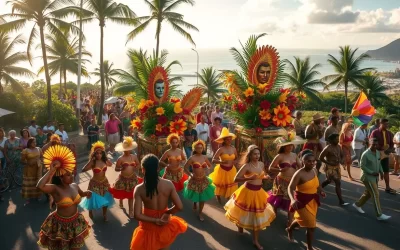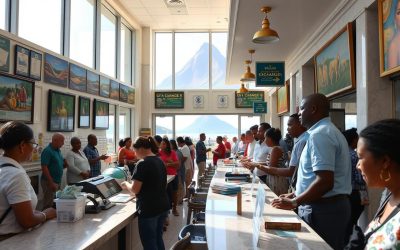✓ Accommodations✓ Flights✓ Rental Cars✓ Tours & Activities ✓ Tours & Activities
Welcome to the vibrant world of Mauritius, a multicultural island nation in the Indian Ocean. Here, the blend of languages reflects its rich history and diverse heritage. While the Constitution doesn’t name a national language, English serves as the medium of instruction in schools and is used in government settings.
French, on the other hand, is widely spoken and considered the language of the more educated. Yet, the most commonly used tongue is Mauritian Creole, spoken by an estimated 90% of the population. This unique mix of languages paints a vivid picture of the country’s colonial past and its journey to independence in 1968.
Understanding this linguistic landscape offers a glimpse into the heart of Mauritius. From government proceedings to everyday conversations, the island’s languages tell a story of unity and diversity. Ready to dive deeper? Let’s explore further!
Overview of Mauritius’s Linguistic Landscape
Step into the heart of a linguistic melting pot. The island’s population reflects a diverse mix of voices, each contributing to its unique identity. With over 1.3 million inhabitants, this small yet vibrant nation thrives on its rich cultural heritage.
Mauritian Creole is the majority language, spoken by an estimated 90% of the population. It serves as the glue that binds different communities together. Whether in casual conversations or family gatherings, this language is a cornerstone of daily life.
Each community plays a vital role in shaping the linguistic landscape. From Indian languages like Bhojpuri and Tamil to colonial influences like French and English, the island’s speech is a testament to its history. The government also uses multiple languages for official purposes, ensuring inclusivity.
Here’s a snapshot of the linguistic diversity:
| Language | Usage |
|---|---|
| Mauritian Creole | Spoken by 90% of the population |
| French | Widely used in education and media |
| English | Official language for government and business |
| Bhojpuri | Spoken by a significant minority |
Every member of society contributes to this linguistic diversity. From the bustling markets to the quiet countryside, the interplay of languages paints a vivid picture of unity in diversity. This rich tapestry of communication is what makes the island truly special.
Historical Evolution of Language in Mauritius
Discover the fascinating journey of language evolution on this multicultural island. From the 10th century, when Arab traders first arrived, to the modern era, historical events have shaped its linguistic identity.
The Portuguese arrived in the 16th century, leaving traces of their influence. However, it was the Dutch in the 17th century who began formal colonial administration, introducing new terms and practices.
French colonial rule in the 18th century marked a turning point. French became the dominant language of governance and education, laying the foundation for modern linguistic structures. This period also saw the emergence of Mauritian Creole, a unique blend of French and African languages.
The 19th century brought significant changes with British administration. English was introduced as the official language, creating a bilingual framework that persists today. The constitution later reinforced this, ensuring English remained central to government proceedings.
These historical shifts highlight the differences between languages and their lasting impact. Understanding this evolution offers insight into the island’s cultural identity and the role of language in shaping its future.
Mauritius: Official and widely spoken languages Today
Explore the dynamic linguistic landscape of this multicultural island. Today, the language spoken reflects a blend of tradition and modernity. Mauritian Creole remains the most common tongue, used by over 86.5% of the population. It’s the heart of daily conversations, connecting people across communities.
English and French continue to play vital roles. English is the primary language for government and business, ensuring clarity in official settings. French, on the other hand, is widely used in education and media, adding a layer of sophistication to communication.
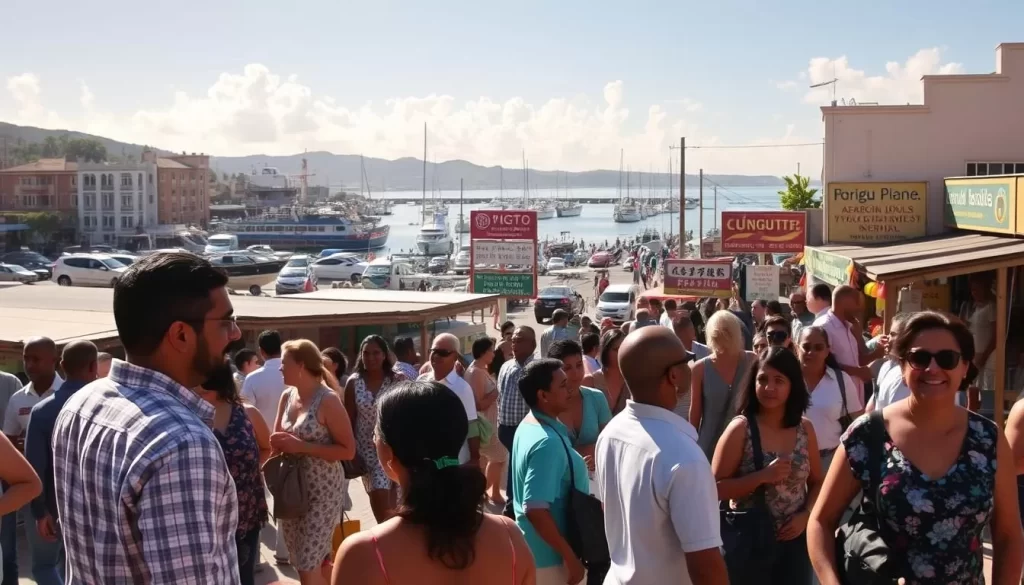
In everyday life, the interplay of these languages is seamless. From casual chats to formal meetings, the nation thrives on its multilingual identity. This dynamic ensures inclusivity and adaptability in a rapidly changing world.
Here’s how these languages shape modern society:
- Mauritian Creole: The glue of daily interactions, spoken by the majority.
- English: The backbone of governance and professional activity.
- French: A bridge between education and cultural expression.
This linguistic diversity is a testament to the island’s rich heritage. It’s a living example of how language spoken can unite a nation while celebrating its unique identity. Whether in boardrooms or marketplaces, the blend of English, French, and Creole continues to define this vibrant society.
The Role of English and French in Government and Education
Understanding the role of English and French in governance and education reveals the island’s commitment to inclusivity. English, as per the constitution mauritius, is the official language for government proceedings, ensuring clarity in law and public service. This framework supports seamless communication in courts, parliament, and other institutions.
French, on the other hand, plays a significant role in education and media. It’s widely used in schools, adding a layer of sophistication to learning. This dual-language approach ensures that students are well-prepared for both local and global opportunities.
Day-to-day activity in schools and offices reflects these policies. Teachers often switch between English and French, creating a dynamic learning environment. In government offices, documents are drafted in English, while French is used for public announcements.
Here’s how these languages shape daily life:
- English: The backbone of government and legal systems.
- French: A bridge between education and cultural expression.
This time-tested approach ensures that the island’s linguistic policies remain inclusive and effective. Whether in a classroom or a courtroom, the blend of English and French continues to define the nation’s identity.
The Dominance of Mauritian Creole as the Lingua Franca
Mauritian Creole stands as the unifying voice of the island, bridging diverse communities. This language, spoken by over 85% of the population, is the heart of daily life. Its roots trace back to French colonization, blending elements from African, Indian, and European tongues to create a unique language accessible to all.
What makes Mauritian Creole so dominant? Its simplicity and inclusivity. Unlike other languages, it doesn’t belong to a single ethnic group. Instead, it reflects the shared history and cultural fusion of the nation. This makes it the perfect tongue for a multicultural society.
Here’s how Mauritian Creole unites the population:
- It serves as the primary language for over 1 million native speakers.
- Its origin in French makes it familiar to those who speak colonial languages.
- It fosters a sense of community, connecting people across different backgrounds.
This language isn’t just a means of communication—it’s a symbol of unity. Whether in markets, homes, or public spaces, Mauritian Creole brings people together. Its evolution mirrors the island’s journey, making it an integral part of its identity.
| Aspect | Details |
|---|---|
| Native Speakers | 1,090,000 |
| Total Speakers | 1,335,000 |
| Primary Language | Spoken by 85% of the population |
Mauritian Creole’s dominance isn’t just about numbers. It’s about connection. It’s the language of shared experiences, cultural pride, and everyday life. As you explore the island, you’ll see how this tongue weaves together the stories of its people.
Indian and Asian Languages: Bhojpuri, Tamil, and More
Dive into the rich tapestry of Indian and Asian languages that shape the cultural identity of this vibrant island. These tongues are more than just means of communication—they are a bridge to heritage, tradition, and community.
Bhojpuri, Tamil, Hindi, and other Indian languages play a vital role in daily life. They are often used during festivals and religious events, keeping traditions alive. For example, during Hindu festivals, prayers and rituals are conducted in these languages, connecting the population to their roots.

The government supports this linguistic diversity by allowing these languages to thrive in cultural and educational settings. Schools offer courses in Bhojpuri, Tamil, and other Asian languages, ensuring younger generations stay connected to their heritage.
Here’s a closer look at the significance of these languages:
| Language | Role |
|---|---|
| Bhojpuri | Used in festivals and family gatherings |
| Tamil | Central to religious and cultural activity |
| Hindi | Spoken by a significant number of people |
| Chinese | Preserved within the Chinese community |
These languages are not just spoken—they are celebrated. They define the multicultural identity of the country, making it a unique blend of traditions and modernity. Whether in a temple or a classroom, their presence is a testament to the island’s rich heritage.
As you explore this island, you’ll see how these languages bring people together. They are a reminder of the shared history and cultural pride that make this place so special. At the end of the day, it’s these voices that tell the story of unity in diversity.
How Multilingualism Reflects Mauritius’s Multiethnic Culture
The linguistic diversity of this island nation is a mirror of its multiethnic culture. Each group and member contributes to a vibrant tapestry of languages, shaped by centuries of history and interaction. From the bustling markets to serene temples, the blend of voices tells a story of unity in diversity.
Religion plays a significant role in this linguistic landscape. Whether it’s prayers in Hindi at a Hindu temple or sermons in French at a church, each community preserves its heritage through language. This connection between religion and speech strengthens cultural identity and fosters mutual respect.
Over the years, economic activity has also influenced language use. In business settings, English is the preferred tongue, ensuring clear communication in a globalized world. Meanwhile, local markets thrive on Creole, creating a sense of belonging for every person involved.
Here’s how multilingualism shapes the country’s identity:
- It bridges diverse communities, fostering unity.
- It preserves cultural heritage through religion and traditions.
- It supports economic growth by enabling seamless business interactions.
As time passes, the linguistic landscape continues to evolve. Each year brings new interactions, refining the way people communicate. This dynamic process ensures that the island remains a vibrant, inclusive society.
In every corner of the country, you’ll find evidence of this linguistic harmony. From schools to workplaces, the blend of languages reflects the rich, multiethnic culture that defines this nation. It’s a living testament to the power of diversity.
The Impact of Colonial History on Language Usage
The colonial history of this island has deeply shaped its linguistic identity. From Dutch and French rule to British administration, each era left its mark on the way people communicate today. This rich past continues to influence the land and its government policies.
During French colonial rule, French became the language of administration, education, and culture. Even after the British took control in 1810, French remained influential. This bilingual framework laid the foundation for modern language usage.
The British introduced English as the official language, but French persisted in law and education. This duality created a unique linguistic landscape. Today, both languages coexist, reflecting the island’s complex history.
Here’s how colonial history shaped language usage:
- French established itself as a language of prestige and culture.
- English became the official language for government and law.
- Mauritian Creole emerged as a unifying tongue for the population.
Historical festivals also played a role in preserving linguistic traditions. These events celebrated cultural diversity, ensuring that multiple languages thrived. The end of colonial rule marked a new chapter, but its linguistic legacy remains strong.
Language and National Identity in a Modern Republic
Language shapes the soul of a nation, and in this modern republic, it’s the cornerstone of identity. From the streets to the halls of government, the way people communicate reflects their shared history and values. Every person contributes to this linguistic tapestry, making it a vital part of the country’s story.
Since gaining independence in 1968, the republic has embraced its multilingual heritage. This diversity isn’t just about words—it’s about unity. Whether in schools, workplaces, or homes, the blend of languages fosters a sense of belonging for every member of society.
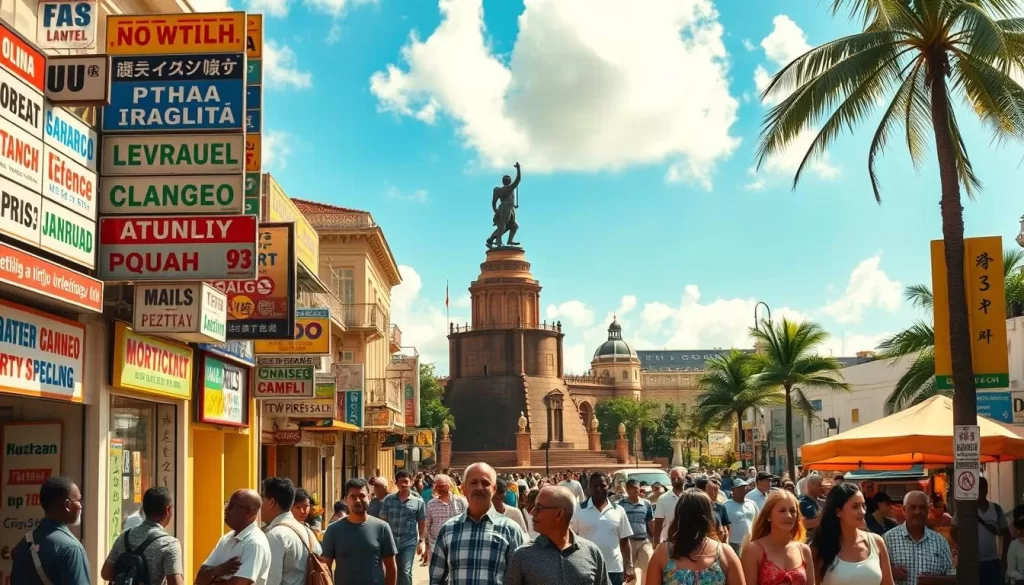
- It connects people across different backgrounds, creating a shared culture.
- It preserves traditions, ensuring that history is passed down through generations.
- It supports government policies, promoting inclusivity and equality.
Every year, the republic evolves, and so does its linguistic landscape. This dynamic process ensures that the population remains united while celebrating its unique heritage. It’s a living example of how language can shape a nation’s identity.
Take a moment to reflect on your own views about language and identity. How does the way you speak connect you to your community? In this republic, language isn’t just a tool—it’s a symbol of pride and unity.
| Aspect | Role in National Identity |
|---|---|
| Language Diversity | Fosters unity and inclusivity |
| Government Policies | Promotes multilingualism |
| Cultural Preservation | Keeps traditions alive |
From the bustling cities to the quiet countryside, the interplay of languages paints a vivid picture of unity in diversity. This modern republic thrives on its linguistic heritage, making it a unique and inspiring place.
The Role of Language in Business, Media, and Tourism
Language is a powerful tool that drives success in key sectors like business, media, and tourism. In this vibrant country, the ability to communicate effectively shapes economic growth and enhances visitor experiences.
In the business world, English is the primary language for administration and professional communication. This ensures clarity in contracts, meetings, and international partnerships. French, on the other hand, is widely used in media, adding a layer of sophistication to news and entertainment.
Tourism thrives on multilingual skills. Visitors feel welcomed when service providers speak their language. Whether it’s a hotel receptionist or a tour guide, the ability to switch between languages enhances the overall experience.
Here’s how language impacts these sectors:
| Sector | Language Role |
|---|---|
| Business | English for contracts and meetings |
| Media | French for news and entertainment |
| Tourism | Multilingual skills for better service |
Over time, the economy has benefited from this linguistic diversity. Companies can attract international clients, and media outlets reach a broader audience. Tourists, too, enjoy seamless interactions, making them more likely to return.
Every member of society plays a role in this success. From a person working in hospitality to a journalist crafting a story, language is the bridge that connects people and opportunities. This dynamic interplay ensures that the country remains competitive and welcoming.
Language in Daily Mauritian Life: Food, Festivals, and Etiquette
Language weaves through every aspect of daily life, from the kitchen to the festival grounds. It’s not just about communication—it’s about identity, tradition, and connection. Whether you’re savoring a local dish or celebrating a vibrant festival, language plays a key role in shaping these experiences.
Language in Culinary Traditions
Food is a universal language, and here, it’s a reflection of cultural heritage. Recipes are passed down through generations, often with stories tied to specific words or phrases. For example, the name of a dish might reveal its origins or the community that created it.
When you visit a local market, you’ll hear a mix of languages as vendors describe their products. This multilingual exchange adds depth to the culinary experience. It’s not just about taste—it’s about understanding the history behind each dish.
- It preserves recipes and cooking techniques within families.
- It connects people through shared meals and stories.
- It highlights the diversity of ingredients and flavors.
Language at Cultural Festivals
Festivals are a time for celebration, and language is at the heart of these events. Whether it’s a religious holiday or a cultural festival, the words spoken during rituals and performances carry deep meaning.
During Diwali, for example, prayers are recited in Hindi, connecting participants to their heritage. Similarly, during Chinese New Year, traditional greetings in Mandarin or Cantonese are exchanged. These moments reinforce the importance of language in preserving culture.
Here’s a glimpse of how language shapes festivals:
| Festival | Language Role |
|---|---|
| Diwali | Hindi prayers and rituals |
| Chinese New Year | Traditional greetings in Mandarin |
| Eid | Arabic recitations and blessings |
These celebrations are more than just events—they’re opportunities for cultural exchange. They bring groups together, fostering unity and mutual respect. For more insights into how festivals reflect cultural diversity, explore the culture of Mauritius.
Language is the thread that ties these experiences together. It’s a reminder of the shared history and values that define this vibrant community. Whether you’re enjoying a meal or joining a celebration, you’re part of a story that spans generations.
Regional Variations: Rodrigues, Agaléga, and Beyond
Across the islands of this nation, language takes on unique forms shaped by geography and history. While the main island thrives on its linguistic diversity, outlying regions like Rodrigues and Agaléga have developed distinct practices. These variations reflect the isolation and cultural identity of each island.
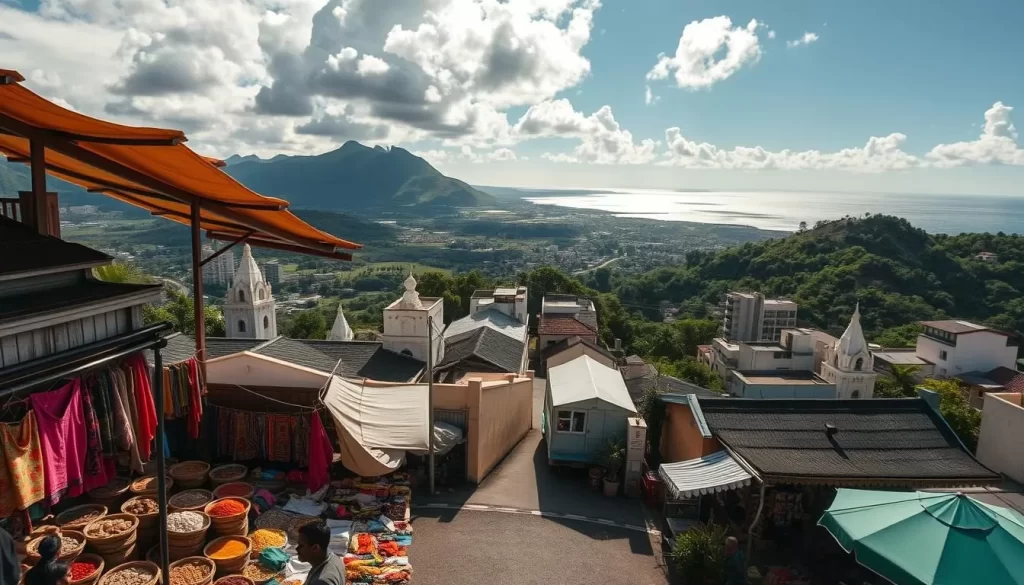
In Rodrigues, for example, Creole remains the dominant language, but it has evolved with local influences. The population here has preserved traditional expressions, creating a unique dialect. This reflects the group‘s commitment to maintaining their heritage despite broader national trends.
Agaléga, on the other hand, has a smaller population and a more isolated economy. Here, the blend of Creole and French is distinct, shaped by years of limited interaction with the main island. This isolation has allowed the community to develop its own linguistic identity.
Here’s a closer look at how these regions differ:
- Rodrigues: A unique Creole dialect with local influences.
- Agaléga: A blend of Creole and French shaped by isolation.
- Main Island: A diverse mix of languages reflecting its multicultural heritage.
These regional variations highlight the importance of geography in shaping language. They also show how smaller groups and members of society preserve their traditions. For more insights into how these regions contribute to the nation’s identity, explore the sustainable development strategies.
Every person in these regions plays a role in maintaining their linguistic heritage. Whether in Rodrigues or Agaléga, the language spoken is a testament to the resilience and adaptability of the country’s diverse population.
Educational Policies and the Multilingual Classroom
Education in this multicultural nation reflects its commitment to linguistic diversity. The government has implemented bilingual strategies to balance local and global languages, ensuring students are well-prepared for the future.
From Standard IV onwards, English is the primary medium of instruction in schools, while French remains widely used in education and media. This dual-language approach helps students navigate both local and international opportunities.
Bilingual Education Strategies
Bilingual education in this country focuses on maximizing exposure to both English and French. Research shows that content-based English instruction (CBEI) leads to higher proficiency levels compared to traditional methods.
Schools equipped with modern instructional technologies often achieve better results. However, resource disparities between schools can impact the effectiveness of these strategies.
Here’s how bilingual education benefits students:
- It enhances listening, speaking, reading, and writing skills in both languages.
- It prepares students for global opportunities while preserving local identity.
- It fosters inclusivity by addressing the needs of a diverse population.
Challenges in Language Preservation
Despite the success of bilingual strategies, preserving local languages remains a challenge. Many schools lack the resources to effectively teach both English and regional languages.
The introduction of Kreol as an optional subject has been met with mixed reactions. While some communities embrace it, others remain hesitant, reflecting broader societal attitudes.
Over the years, efforts to integrate regional languages into the curriculum have faced obstacles. Teachers often struggle to balance the demands of global languages with the need to preserve local heritage.
“Language is not just a tool for communication; it’s a bridge to cultural identity and heritage.”
For more insights into how teachers navigate these challenges, explore this study on multilingual classrooms.
Every year, the government and community work together to refine educational policies. These efforts ensure that the island’s linguistic diversity remains a source of strength and unity.
Travel Tips: Communicating in Mauritius
Navigating the linguistic landscape of this island can be both exciting and rewarding. While English is the official language, most locals speak Mauritian Creole in their daily lives. Knowing a few key phrases can make your trip smoother and more enjoyable.
Useful Phrases in Mauritian Creole
Learning basic phrases in Mauritian Creole can help you connect with locals. For example, “Bonzour” means “Good morning,” and “Ki manier?” translates to “How are you?” These simple words can open doors to meaningful interactions.
When ordering a dish, try saying “Mo oulé sa” (I want this) or “Ki sa li?” (What is this?). These phrases can enhance your dining experience and help you explore local cuisine.
Understanding Local Dialects
Local dialects vary across regions, but Creole remains the unifying language. In Rodrigues, for instance, the dialect has unique expressions influenced by its isolation. Understanding these nuances can enrich your travel experience.
During festivals like the new year celebrations, you’ll hear a mix of languages. Pay attention to how different groups express their traditions through speech. This can deepen your appreciation for the island’s cultural diversity.
For more detailed insights, check out this comprehensive travel guide. It’s packed with tips to help you make the most of your visit.
Conclusion
Language is the heartbeat of this vibrant island, shaping its identity and connecting its diverse population. From colonial influences to modern practices, the blend of tongues reflects a rich history and a promising future. Whether in schools, markets, or holiday celebrations, the interplay of languages fosters unity and cultural pride.
The economy thrives on multilingualism, with English driving administration and business, while Creole strengthens community bonds. This linguistic harmony ensures inclusivity and adaptability, making the island a model of diversity.
As you reflect on the role of language, consider how it shapes identities and bridges cultures. To explore more about this fascinating topic, visit this detailed analysis. Every word spoken here tells a story of resilience, unity, and progress.
The above is subject to change.
Check back often to TRAVEL.COM for the latest travel tips and deals.
